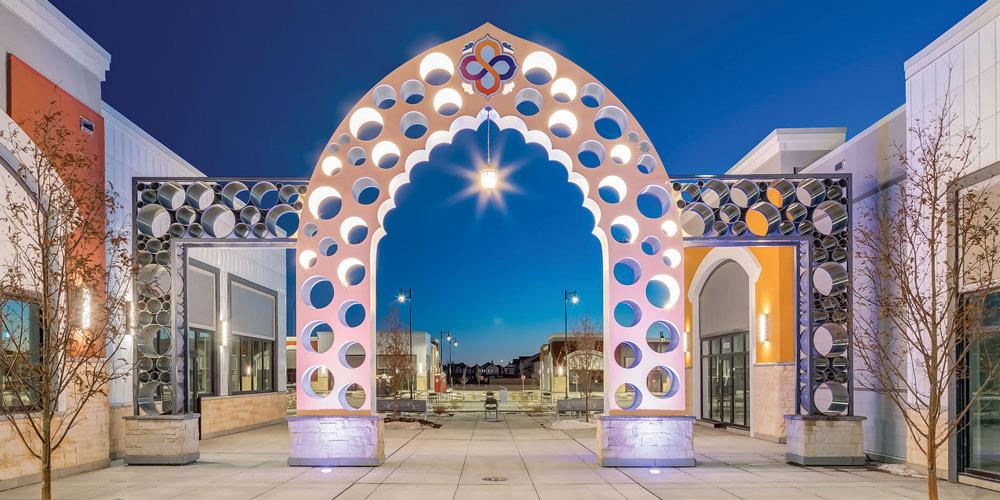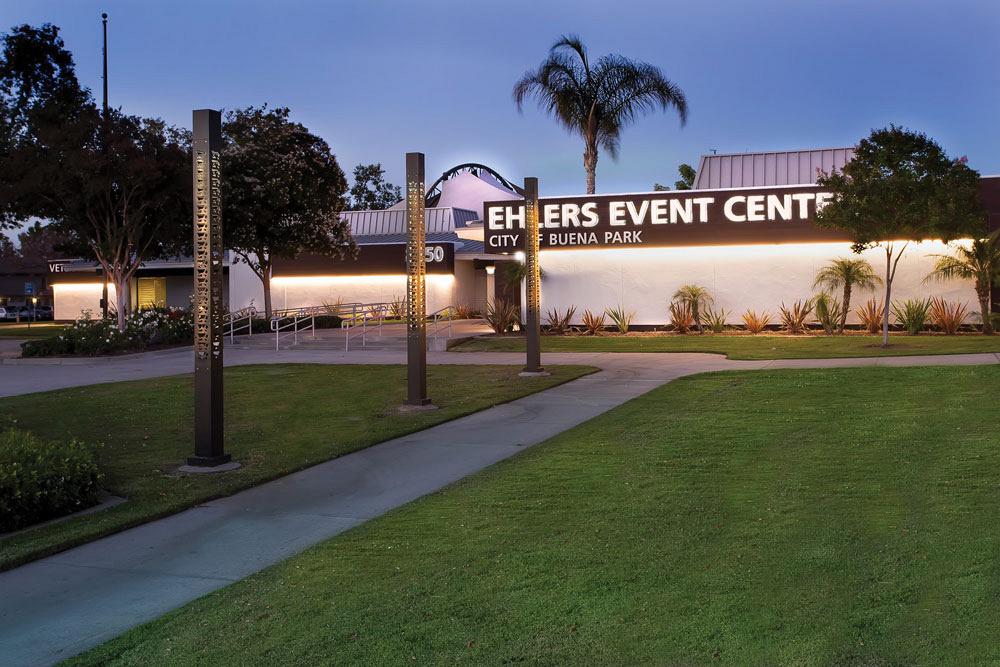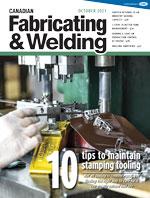Editor
- FMA
- The Fabricator
- FABTECH
- Canadian Metalworking
Shining a light on production control
Solera manages production costs through automation and keeping everything - including gas generation - in-house
- By Rob Colman
- November 15, 2021
- Article
- Fabricating

This Solera project features prominently at the Savanna Bazaar outdoor mall in northeast Calgary. Image: Solera.
Controlling costs is a critical consideration for any fab shop hoping to compete effectively in today’s market. One way to manage these costs is to bring as much work as possible in-house so that no time is lost in shipping costs and delivery delays. This is the approach that Jay Singh, president of Solera Corp., has championed since purchasing the company 11 years ago.
Assembly to Production
Mississauga, Ont.-based Solera is an architectural lighting manufacturer that designs and manufactures custom systems for its clientele.
Singh was an employee at the business before purchasing it.
“Prior to the purchase we were lighting unit assemblers,” said Singh. “The former owner wasn’t interested in pursuing the manufacturing process, but once I purchased the company I immediately moved it in that direction.”
Singh began the transformation with a saw, one press brake, and a turret punch press.
“When you farm things out, you need to buy in volume to get a good price,” he said. “That can be difficult for a custom business like ours.”
Soon, Singh had added two more punch presses and a vacuum forming machine for plastics to his 20,000-sq.-ft. shop.
“We were spending $200,000 a year in plastics before that,” he said. “It just didn’t make sense.”
With the growth of the LED market, Singh invested in a clean room to start producing LEDs in the facility.
Growth and Change
Eventually growth of the business drove Singh to move to a new 40,000-sq.-ft. facility, at which point he added a paint line and updated his cutting practices.

Here we see an example of Solera's products installed in Toronto - unique lighting designed and manufactured at the company's Mississauga facility.
“With the new facility, I decided it was time to move away from punching and invest in a laser,” he said. “The 6-kW fibre that I purchased replaced the three punch presses I had. I had to look at the big picture. With the laser, I have no tool setups, it doesn’t require an expert to manage it at all times, and there’s no need for dies or sharpening tools.”
It was important to Singh that he control his cutting-related costs as well. That meant managing the gas supply.
Solera uses aluminum for all of its products, so the laser would be cutting aluminum from 40 thousandths to ¾-in. thick. It’s important to Singh that his team not do too much post-processing of parts, so he uses nitrogen to cut to ensure excellent edge quality with little to no oxidation.
Instead of purchasing bulk packs from a supplier, Singh invested in an on-site nitrogen generation system from CRU Air + Gas. The system includes a BOGE low-pressure compressor, air treatment, Holtec pressure swing adsorption (PSA) nitrogen generator, and BOGE high-pressure booster system.
“It’s all about controlling costs,” he said. “Basically, we run our laser 9 to 10 hours a day. Using that much nitrogen, a bulk pack delivery approach doesn’t make sense.”
Nitrogen Generation Basics
The rising costs involved in getting bulk delivery of assist gases has encouraged shops like Solera to consider the use of shop air or in-house assist gas generation for laser cutting. A big reason for this is how the technology has developed over the past decade and the cost advantages vs. bulk.
Purity in on-site nitrogen generation has reached a stable 99.9995 per cent, which is greater than grade 5.0 (99.999 per cent pure). If you are cutting thick materials that require an edge with no discolouration, and you are trying to reduce post-processing, this level of purity can be a real boon. Obviously, working with thin-gauge mild steel probably wouldn’t require this. But at a shop like Solera, working with ¾-in. aluminum, it is a definite benefit.
So how does the process work? Solera’s system uses pressure swing adsorption (PSA) to generate nitrogen, a method that is becoming quite common. Each module has two pressure vessels filled with a carbon molecular sieve (CMS). The system passes purified compressed air through one of the vessels, whereby the oxygen molecules in the air are adsorbed while flowing through the CMS. This adsorption process continues until the activated carbon is saturated with oxygen molecules as the nitrogen-rich stream flows to the receiver. The same process then starts in the second vessel while the saturated container regenerates itself.
The system is equipped to handle one to eight modules so that companies can ramp up their capacity as necessary. The purity level, delivery flow, and nitrogen output all can be adjusted for a user’s requirements.
“How we size a system is that a manufacturer will give a minimum purity and the flow required,” said Shannon de Souza, president, CRU Air + Gas. “When they give the flow, the manufacturer typically provides it as a nozzle size. As you change to larger-sized nozzles, the gas consumption gets dramatically higher. We also need to know what kind of metal the customer will be cutting. Solera, for instance, uses a lot of aluminum and some stainless. Oxidation on those metals is a concern because you get a different finish on those metals depending on the purity. What might be important in terms of purity for one customer won’t be the same for another. We had a customer that is using air because they aren’t concerned about oxidation. In that case, they are happy with compressed air. As long as you have high-quality dry air, for some companies the finish will be good enough and any oxidation is taken care of in post-processing.”
With higher purity, you are spending more to generate the nitrogen, so payback on a generation system takes longer, but it’s still attractive compared to bulk nitrogen. The name of the game is to get the ideal purity for your applications.
“With a given system, the higher the purity of the nitrogen you generate, the more your flow rate drops,” said de Souza. Standard PSA nitrogen-generation systems can’t be operated higher than around 150 psig, so the nitrogen’s pressure is boosted after it leaves the generator to match the needs of the cut and thickness of the material being used. A higher pressure will provide a sharper edge on a part.
Automating as Needed
Solera has the same challenge as any other fabricator today—finding experienced operators to run its machines. Through automation, Solera isn’t really trying to reduce staff on the floor, as it is speeding delivery to customers, keeping costs reasonable, and creating an environment where inexperienced people can be brought on the floor and trained as necessary over time.
Singh’s most recent investment is another case in point. Earlier this year, he brought in an Amada HRB series press brake with patented automatic tool changer, which the company says can achieve even complex tool setups in four minutes or less.
“This is a huge time savings for me,” said Singh. “We can produce the bend sequences offline as we do the nesting for the laser, and then when parts arrive at the machine, the operator simply scans a barcode and the setup is loaded into the machine. And all of it is precise; the bending is precise from the very start, and you can do four stages in one setup, making it much faster to bend.
“The time savings involved in not having to have operators monkeying around with tool changes alone is a huge savings for us,” he continued. “But I also don’t need a highly skilled press brake operator on the machine at all times either, which is helpful because they are hard to find.”
The relative ease of use of the automatic tool changer on the press brake and the laser has given Singh the ability to cross-train his team of 30; each person now can operate a number of machines on the shop floor as necessary.
“It makes it easier to hire people when you have these technologies,” he said. “And in the process we control more costs. That’s what brings customers back—keeping their costs down and delivering promptly.”
Editor Robert Colman can be reached at rcolman@canadianfabweld.com.
Solera Corp., soleracorp.com
About the Author

Rob Colman
1154 Warden Avenue
Toronto, M1R 0A1 Canada
905-235-0471
Robert Colman has worked as a writer and editor for more than 25 years, covering the needs of a variety of trades. He has been dedicated to the metalworking industry for the past 13 years, serving as editor for Metalworking Production & Purchasing (MP&P) and, since January 2016, the editor of Canadian Fabricating & Welding. He graduated with a B.A. degree from McGill University and a Master’s degree from UBC.
subscribe now


Keep up to date with the latest news, events, and technology for all things metal from our pair of monthly magazines written specifically for Canadian manufacturers!
Start Your Free Subscription- Industry Events
Automate 2024
- May 6 - 9, 2024
- Chicago, IL
ANCA Open House
- May 7 - 8, 2024
- Wixom, MI
17th annual Joint Open House
- May 8 - 9, 2024
- Oakville and Mississauga, ON Canada
MME Saskatoon
- May 28, 2024
- Saskatoon, SK Canada
CME's Health & Safety Symposium for Manufacturers
- May 29, 2024
- Mississauga, ON Canada






















